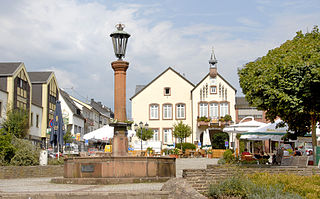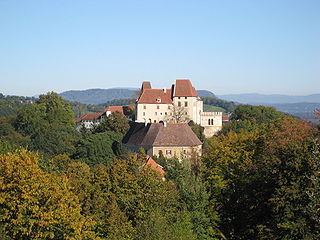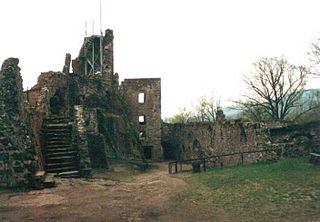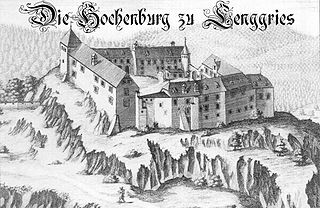Merzig-Wadern is a Kreis (district) in the northwest of the Saarland, Germany. Neighboring districts are Trier-Saarburg, Sankt Wendel, Saarlouis, the French département Moselle, and Luxembourg.

DBLP is a computer science bibliography website. Starting in 1993 at Universität Trier in Germany, it grew from a small collection of HTML files and became an organization hosting a database and logic programming bibliography site. Since November 2018, DBLP is a branch of Schloss Dagstuhl – Leibniz-Zentrum für Informatik (LZI). DBLP listed more than 5.4 million journal articles, conference papers, and other publications on computer science in December 2020, up from about 14,000 in 1995 and 3.66 million in July 2016. All important journals on computer science are tracked. Proceedings papers of many conferences are also tracked. It is mirrored at three sites across the Internet.

Dagstuhl is a computer science research center in Germany, located in and named after a district of the town of Wadern, Merzig-Wadern, Saarland.

Wadern is a municipality in the federal state Saarland, which is situated in the southwest of Germany. It is part of the district Merzig-Wadern. Wadern consists of 13 urban districts with approximately 16.000 inhabitants. With 143 inhabitants per km2 it is sparsely populated, but, with an area of 111 km2, Wadern is the third largest municipality in Saarland after Saarbrücken and St. Wendel. The town is divided into 14 urban districts and altogether 24 villages belong to the commune. The town is part of the Moselle Franconian language area.

Schloss Johannisburg is a schloss in the town of Aschaffenburg, in Franconia in the state of Bavaria, Germany. It was erected between 1605 and 1614 by the architect Georg Ridinger for Johann Schweikhard von Kronberg, Prince Bishop of Mainz. Until 1803, it was the second residence of the Prince Bishop of Mainz. It is constructed of red sandstone, the typical building material of the Spessart, the hills near Aschaffenburg.

Wolfstein was a minor principality in the Holy Roman Empire, centered on Wolfstein castle, near Neumarkt in der Oberpfalz.

Niesytno Castle was a castle in the south-west of Poland, near the village of Płonina, situated west of Bolków. After the castle turned into ruins, Płonina Palace was built at the same site, though the place is still often referred to as Niesytno Castle. It has decayed over the years, and only its ruins have remained. It is in private hands and closed to the public, but is along the tourist Piastowskich Castle Route.

Schloss Veldenz in the Hunsrück upland, on a steep vale draining into the Mosel is a castle ruin about 1.5 kilometres (0.9 mi) southeast of the village of Veldenz in the German state of Rhineland-Palatinate.
Susanne Boll is a Professor for Media Informatics and Multimedia Systems in the Department of Computing Science at the University of Oldenburg, Germany. Boll is a member of SIGMM of the ACM and is a member of the board at the research institute OFFIS. She founded and directs the HCI Lab at the University of Oldenburg and OFFIS.

Finstergrün Castle is a castle in the state of Salzburg, Austria. Burg Finstergrün is 1,087 metres (3,566 ft) above sea level.

Schloss Seggau is a castle situated in the locality Seggauberg in southern Styria, Austria. It is located on a wooded hill overlooking the town of Leibnitz. Schloss Seggau is situated at a height of 344 metres (1,129 ft).

Hohnstein Castle is one of the largest and best-preserved castle ruins in Germany and is located near Neustadt in the vicinity of Nordhausen in Thuringia.

Grenzau Castle is a ruined spur castle at 250 m above sea level (NN) near Höhr-Grenzhausen in the county of Westerwaldkreis in the state of Rhineland-Palatinate. It is the only castle in Germany with a triangular bergfried.

The Hohenburg is a ruined medieval castle near Lenggries in Bavaria, Germany. Once a dominating centre of power in the region, it was destroyed by fire on 21 July 1717.













